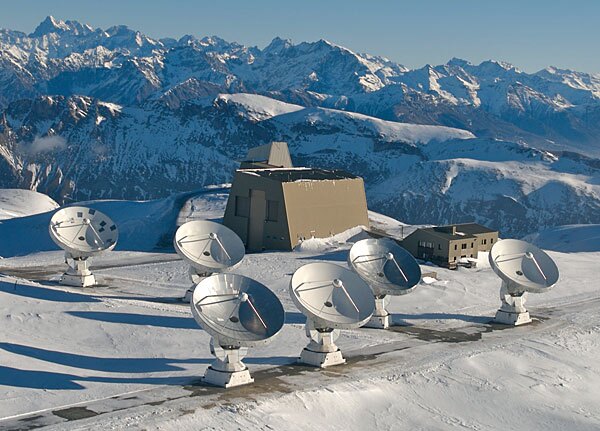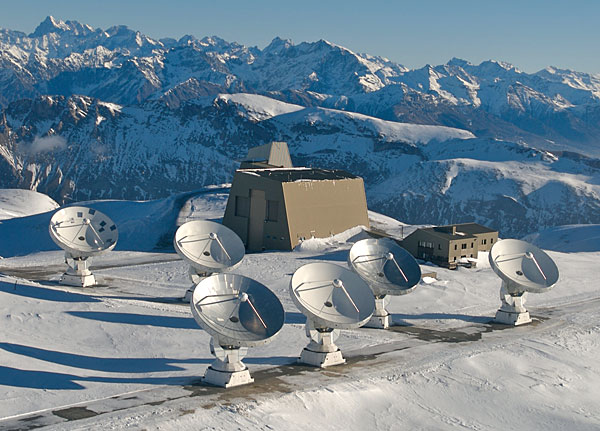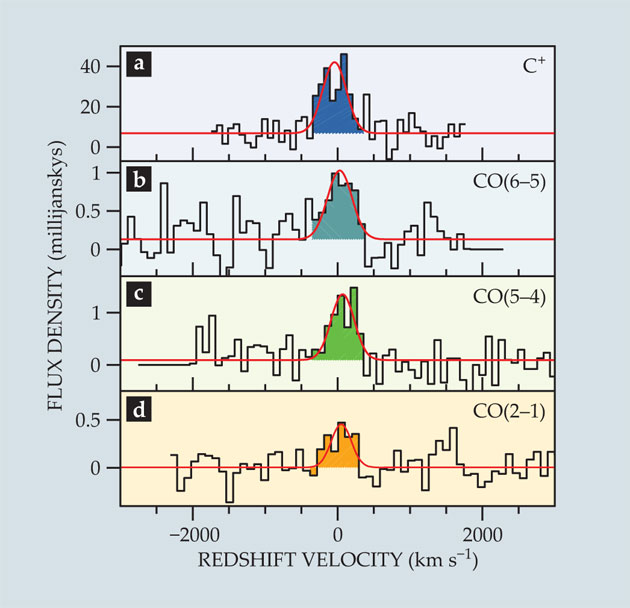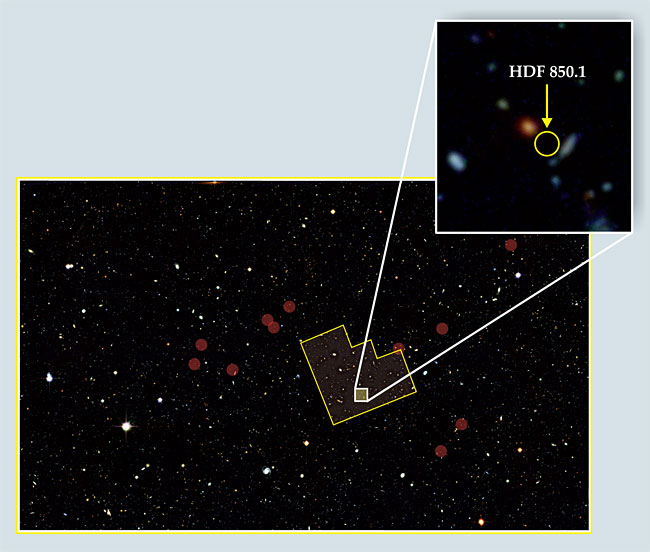Hidden starburst galaxy pinpointed at high redshift
DOI: 10.1063/PT.3.1664
For 10 days in late December 1995, the Hubble Space Telescope trained near-UV, visible, and near-IR detectors on a tiny patch of sky adjacent to the Big Dipper. Angled normal to the disk of the Milky Way and therefore virtually unobscured by nearby stars, Hubble enjoyed an immaculate view of the distant cosmos. The composite image it produced, the Hubble Deep Field, revealed some 3000 galaxies, some so remote that we see them as they were just a few hundred million years after the Big Bang. (See the article by Henry Ferguson, Robert Williams, and Lennox Cowie, Physics Today, April 1997, page 24
In 1998 observers at the James Clerk Maxwell Telescope in Mauna Kea, Hawaii, duplicated the Hubble survey using a far-IR telescope known as the Submillimeter Common User Bolometer Array (SCUBA). One would expect that if you overlaid their image with Hubble’s, the bright objects in the SCUBA image would align with galaxies in the Hubble Deep Field; galaxies that emit intensely in the far-IR—in the so-called submillimeter range—should generally be detectable in visible surveys as well. Curiously, however, the brightest splotch in the SCUBA image, a galaxy dubbed HDF 850.1, has no visible counterpart in the Hubble Deep Field.
Astronomers have struggled for more than a decade to determine HDF 850.1’s precise whereabouts, size, and composition. SCUBA and subsequent detectors were ill-equipped to gather the spectroscopic data from which one might glean such details. By all appearances, though, HDF 850.1 is distant. Guesses based on the approximate shape of its IR spectrum place the galaxy at redshifts z between 1.7 and 4.1.
It comes as something of a surprise, then, that new observations 1 by an international group headed by Fabian Walter (Max Planck Institute for Astronomy, Heidelberg, Germany) peg HDF 850.1’s redshift at nearly 5.2. According to that estimate, by far the most confident to date, the luminous burst of radiation emanating from HDF 850.1 originated roughly a billion years after the Big Bang.
A blind search
In theory, determining a celestial object’s z is straightforward: If one can detect a line in the object’s emission spectrum and attribute it to a known atomic or molecular transition, then the redshift is related to the quotient of the peak’s observed frequency and the transition’s intrinsic emission frequency. But with no foreknowledge of which line to look for and where in the spectrum to find it, the process is akin to finding a needle—actually, a particular needle among many potential impostors—in a haystack.
A few years ago, such a blind hunt for spectral lines would technically have been doable, but it would have taken an impractically long time. Thanks to recent upgrades at the Plateau de Bure millimeter-wave interferometer, pictured in figure 1, Walter and colleagues were able to carefully survey a substantial swath of HDF 850.1’s spectrum in a matter of days.

Figure 1. The Plateau de Bure interferometer, among the most sensitive millimeter-wave detectors in the world, sits nearly a mile and a half above sea level in the French Alps. Using data obtained with the interferometer, an international team of observers determined the cosmic age of HDF 850.1, the brightest source of submillimeter radiation in the Hubble Deep Field region.
IRAM/Rebus

Their search turned up two emission lines, at 93 and 112 GHz. Taken individually, there would have been no way to attribute either line to a specific transition. But the lines’ spacing was a strong hint that they corresponded to specific rotational transitions of carbon monoxide.
With sufficient information to estimate z, the researchers could then predict the locations of additional spectral lines. In short order, they found an emission line corresponding to C+ and a third CO line, detected at the Karl G. Jansky Very Large Array in New Mexico. The four lines, shown in figure 2, are consistent with z = 5.183, with an uncertainty of less than 0.1%.

Figure 2. Emission lines corresponding to (a) singly ionized carbon and (b–d) various rotational transitions of carbon monoxide indicate that the presumed starburst galaxy HDF 850.1 lies at redshift 5.183, meaning we see the galaxy as it was a mere billion years after the Big Bang. The red curves are fits to the data (black). Here, zero velocity denotes the expected location of each spectral line given the deduced redshift. One millijansky is equivalent to 10−26 W m−2 Hz−1. (Adapted from ref.

More than meets the eye
When astronomers search the sky for submillimeter radiation, they are typically looking for warm interstellar dust. In turn, warm interstellar dust usually signals a starburst, a galaxy in the midst of a brief, intense bout of star formation. The dust, which originates as stellar ejecta, absorbs the stars’ UV photons and reradiates them at submillimeter wavelengths.
Accordingly, astronomers have always supposed HDF 850.1 to be a starburst, and the spectroscopic data newly reported by Walter and coauthors support that notion. Judging by the intensity of the CO lines, the team estimates that nearly 25% of HDF 850.1’s mass is molecular hydrogen, the main ingredient of a stellar nursery. The Milky Way, by contrast, is less than 1% molecular hydrogen. Also, HDF 850.1’s spectral energy distribution suggests the galaxy is churning out new stars at about 850 solar masses per year, which rivals the rate of all 3000 galaxies in the Hubble Deep Field combined and is nearly 1000 times faster than our Milky Way.
If HDF 850.1 truly is a starburst, it should be producing an abundance of UV and visible photons. Why didn’t Hubble detect it?
The likely explanation, says Walter, is that HDF 850.1’s stars are so enshrouded in dust that we can’t see them. A fortuitously located dust cloud might well have absorbed the bulk of UV photons that would otherwise have arrived at Earth, redshifted, as visible and near-visible light. Dust is a less efficient absorber of visible photons, but those photons would have been redshifted into the mid-IR, beyond the range of the Hubble Deep Field and other optical surveys.
If HDF 850.1 is in fact an obscured starburst, and if there are more galaxies like it, then it’s possible that the astronomical surveys used to reconstruct the cosmic history of star-formation are significantly, and systematically, undercounting the population of stars in the early universe.
“Objects like HDF 850.1, because they don’t show up in optical surveys, are generally not included in the usual estimates of high-redshift star-formation history,” explains Lennox Cowie of the University of Hawaii’s Institute for Astronomy. “My own suspicion would be that they are really common. But we will need larger samples to know for sure.” He anticipates that the answer may soon come from the Atacama Large Millimeter/Submillimeter Array, which, when complete, will be the world’s most sensitive millimeter- and submillimeter-wave telescope. (See Physics Today, January 2012, page 20
Harvard astrophysicist Avi Loeb cautions, however, that what we’re observing may not be a starburst but rather the afterglow of a recently extinguished quasar. A quasar, the intense burst of light emitted when a black hole accretes a massive cloud of gas, would certainly have warmed any nearby dust. “And if the quasar turned off recently,” says Loeb, “it’s possible that the dust just hasn’t cooled yet.”
Two’s company, thirteen’s a crowd
High-redshift starbursts and quasars are thought to be common harbingers of protoclusters, the primordial overdensities that eventually mature into galaxy clusters like those seen today. So when Walter and coworkers identified the presumed starburst HDF 850.1 as lying at z ≈ 5.2, they recruited two teams working at the W. M. Keck Observatory at Mauna Kea in Hawaii—one led by Mark Dickinson (the National Optical Astronomy Observatory), the other by Richard Ellis (Caltech)—to look for other galaxies in the vicinity.
Within the Great Observatories Origins Deep Survey–North—which covered a cosmic neighborhood, pictured in figure 3, that encompasses the Hubble Deep Field—the two teams found 11 galaxies having z between 5.183 and 5.213. Adding in HDF 850.1 and a 5.2-redshift quasar discovered a decade ago yields a baker’s dozen of 5.2-redshift galaxies in a patch of sky where, assuming a random distribution, one would expect to see just two or three.

Figure 3. An ancient protocluster. All told, the Great Observatories Origins Deep Survey–North region, pictured here, includes 13 galaxies that are known to have redshifts z ≈ 5.2; were the galaxies randomly distributed in space, one would expect to find just two or three. Circles indicate the galaxies’ approximate locations, and the area outlined in yellow is the Hubble Deep Field. Curiously, one member of the cluster, HDF 850.1 (inset), can’t be seen in optical surveys. (Image courtesy of Fabian Walter, Max Planck Institute for Astronomy.)
FABIAN WALTER, MAX PLANCK INSTITUTE FOR ASTRONOMY

Computer simulations predict that such overdensities should begin to appear near the billion-year mark of cosmic history, but supporting observational evidence has been hard to come by, largely because distant galaxies are often extremely faint. “There had been just one reported observation of an overdensity at redshift 5 or higher,” says Walter, referring to a 2011 study that reported a 5.3-redshift protocluster in the Cosmological Evolution Survey. 2 “Now there are two.”
References
1. F. Walter et al., Nature 486, 233 (2012). https://doi.org/10.1038/nature11073
2. P. L. Capak et al., Nature 470, 233 (2011). https://doi.org/10.1038/nature09681




